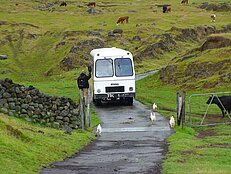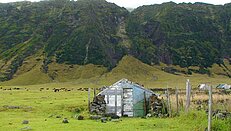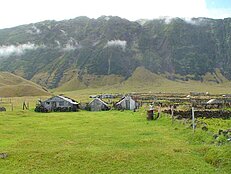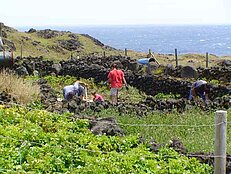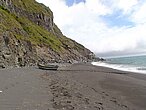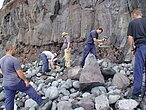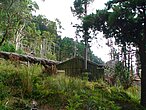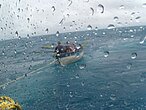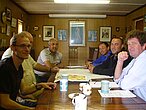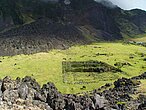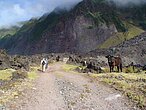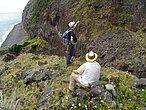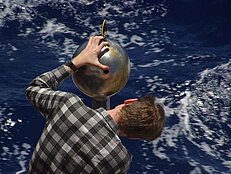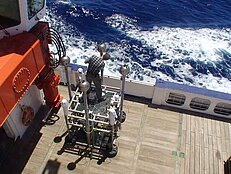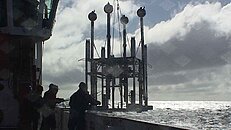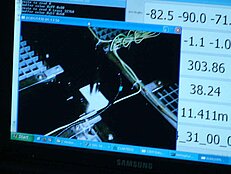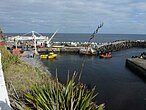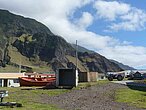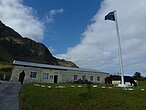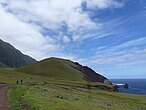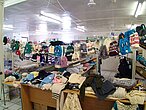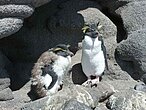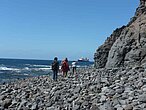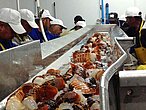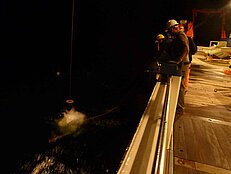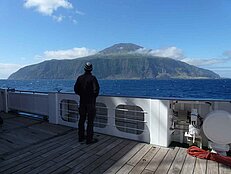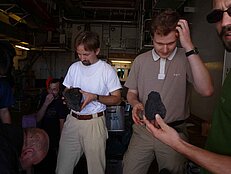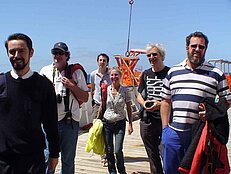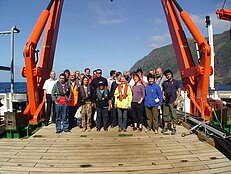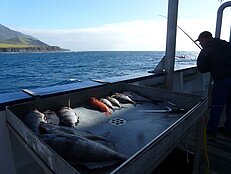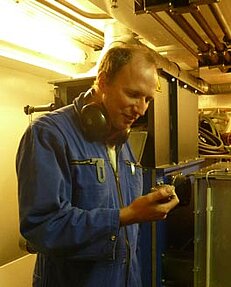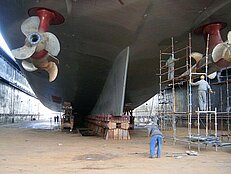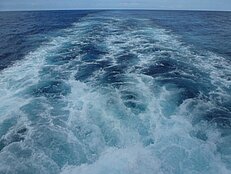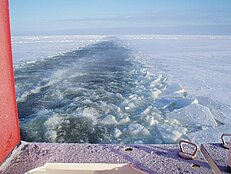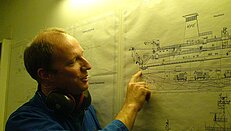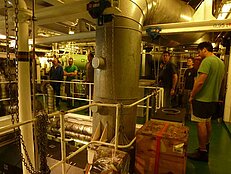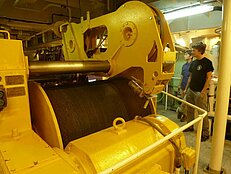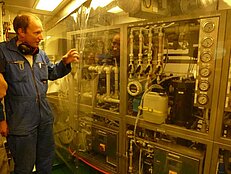Die Expedition MSM20/2 nach Tristan da Cunha ist Teil des Projekts ISOLDE und des DFG-Schwerpunktprogramms SAMPLE. Weitere Informationen finden Sie hier:
Der Tristan & Isolde Blog
Hier können Sie unserer Forschungsreise nach Tristan da Cunha und von dort weiter nach Recife (Brasilien) folgen. Wir bieten Ihnen Einblicke in unser wissenschaftliches Projekt, in die Freuden und Herausforderungen des Bordlebens und in unsere Erkenntnisse über die Geophysik des Südatlantiks.
4. Februar 2012: Tristan Geology - day 3
Die Blog-Einträge vom 2.-4. Februar stammen von Catherine Rannou, unserer Expeditions-Künstlerin, die die beiden Geologen Ilya Veksler und Jakob Keiding drei Tage lang während der Feldarbeit auf Tristan da Cunha (26. - 28. Januar) begleitet hat. (ÜBersetzung aus dem Französischen von Karin Sigloch)
The most important rock samples have been taken. Today we visit the western part of the island, but this time by public transport: the island's only bus. A bucolic, sunny day, calmer than the previous one. Along little valleys and volcanoes, we encounter cows, ducks, donkeys, before arriving at the Potato Patches.
At this place of subsistence farming, we find an assemblage of small cabins built from boulders of lava, roofs made from salvaged pieces of corrugated metal, or from pieces of driftwood. The geologists keep taking rock samples on a beach a bit further off, while I take my own "samples", photographic and videographic, in these little patches of earth.
A family is piling up a low wall using lava pieces, a tractor has come directly to the beach in order to get building material. Another family is pulling out potatoes. It feels like a present-day utopia, an self-sufficient society where every thing, every action, keeps to a human scale. Only the volcano and the ocean reach beyond this scale. They are awe-inspiring, and they are the reason that the scientists of "ISOLDE" are here.
3. Februar 2012: Tristan Geology - day 2
Die Blog-Einträge vom 2.-4. Februar stammen von Catherine Rannou, unserer Expeditions-Künstlerin, die die beiden Geologen Ilya Veksler und Jakob Keiding drei Tage lang während der Feldarbeit auf Tristan da Cunha (26. - 28. Januar) begleitet hat. (Übersetzung aus dem Französischen von Karin Sigloch)
At seven in the morning, one of the fishermen confirms that our departure is imminent. The "Wave Dancer", a boat that lives up to its name, will take us to the east of the island. Landing on the beach in a rowboat with five fishermen, one as skilled as the other. We relive a moment from the adventure books of our childhood, of pirate landings in quest of hidden treasures on the beach.
The geologists, helped by the fishermen, locate their target at the steep base of the volcano. This gives occasion for an improvised lecture in geology. Swarms of albatross are gliding overhead, the rockhopper penguins barely move as we pass them by.
Following a request by the administrator, I take digital pictures of the damage caused by a micro-tornado in October. The small pine forest uphill from the beach, which used to protect a farm house, is divided by a corridor of tree stumps that resemble broken match sticks. Pine trees more than 20 meters high have been unrooted. An unlucky cabin has been buried beneath a fallen tree.
Our return is just as acrobatic, and on the way, we pick up some Scottish botanists who are doing field work in the south of the island. They had been out for nine days on the flanks of the volcano, living completely cut off from the settlement.
2. Februar 2012: Tristan Geology - Day 1
Die Blog-Einträge vom 2.-4. Februar stammen von Catherine Rannou, unserer Expeditions-Künstlerin, die die beiden Geologen Ilya Veksler und Jakob Keiding drei Tage lang während der Feldarbeit auf Tristan da Cunha (26. - 28. Januar) begleitet hat. (Übersetzung aus dem Französischen von Karin Sigloch)
We left for Tristan on Wednesday with our geologic, photographic and video equipment. We are staying in a cottage where every detail reminds us that we are in the United Kingdom, but far off the beaten track nevertheless. The tartan of our landlords, the Glass family, is on the wall, recipes from Cornwall are printed on a kitchen towel. We'll be bedded and fed royally, to our great delight.
Thursday, the first morning, is spent on visiting the administrator's office, and the group of fishermen who will accompany us to Sandy Point, a site targeted by Ilya and Jakob for their rock sampling. This beach is hard to access as soon as the weather turns rough, and only experienced mariners can take us there. It will be feasible if the weather cooperates.
In the meantime, we seek out the lava flow of 1961 to take some samples. Ilya and Jakob are looking for olivine inclusions, markers that will tell them whether the lava originates from a deep magma source, which would imply that Tristan is underlain by a mantle plume, or whether the magma source is superficial.
For my part, I take photos with my pinhole camera. It allows for shots of large focal depth, capturing the geologists in their element, completely immersed in this sea of lavas. Each exposure, made directly on cibachrome color paper, takes me 15 minutes. While this may seem like an eternity in the era of the internet, it amounts to nothing on the time scale of a geologist.
1. Februar 2012: "Sputnik" im Test
Der “Sputnik” ist das Hauptgesprächsthema auf dieser Ausfahrt. Mit seiner bestimmenden Präsenz an Deck und als dekorativer Hintergrund auf Fotos weiß er zu inspirieren. Unsere Künstlerin Catherine, die über die Legende von Tristan und Isolde sinniert hat, vergleicht ihn gerne mit dem “Thron des Königs Marke”.
Aber ohne diese romantische Stimmung zu verderben, wollen wir es nicht unterlassen über die Technik zu sprechen, obwohl der Sputnik im ISOLDE-Projekt keine wissenschaftliche Rolle spielt. Es handelt sich um eine elektromagnetische Quelle in Entstehung (im Prinzip fertig, wie die Besitzer immer wieder versichern), welches zum Testen mitgenommen wurde. Heute wurde der Sputnik ausgesetzt und zog eine beträchtliche Zuschauermenge an. Fast alles funktionierte, sogar die Dinge, die vorher noch nie funktioniert hatten. Wir bekamen perfekte klare Bilder von dem Schlamm auf dem Meeresboden in 1200 m Tiefe zu sehen. Doch nichts ist perfekt und so tauchte ein altes Problem wieder auf, aber insgesamt wurde der Tag als Erfolg betrachtet. Sputnik sah die ganze Zeit über toll aus, natürlich.
Karin Sigloch
31. Januar 2012: Kleine Verschnaufpause
Heute beschäftigen wir uns nur mit leichten wissenschaftlichen Arbeiten. Unsere Fahrtleiter sind immer noch auf der Nightingale Insel und viele von uns haben gestern ein wenig zu viel Sonne auf Tristan abbekommen. Ein ruhiger Tag auf dem Schiff.
30. Januar 2012: Tristan da Cunha entdecken
Unser erster freier Tag wurde genutzt, um die Insel Tristan da Cunha zu erkunden. Natürlich waren wir neugierig, wie es eine Bevölkerung von rund 260 britischen Bürger schafft, auf so begrenztem Platz hauptsächlich als Selbstversorger zusammenzuleben - und das seit 200 Jahren. Hier einige Fotos von der Insel. (Die "Tristanians" betreiben auch eine sehr informative Webseite: www.tristandc.com)
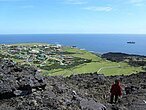
29. Januar 2012: Ein Sonntag zwischen verschiedenen Projekte
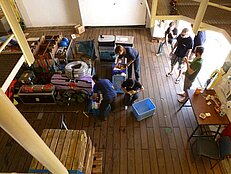
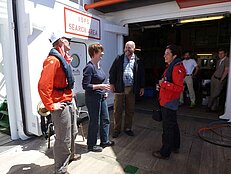
28. Januar 2012: The Engine Room, part II - Ein Umweltengel
During the engine room tour of the MERIAN, our group was particularly fascinated by the two propulsion systems. Neither of them is standard. Unlike commercial ships, which want to go quickly from A to B, a research ship must hold its position in the water about 70% of the time, while scientists experiment in their chosen locations. This requires sophisticated, custom-made steering solutions. In the rear, there are two pod drives that can rotate by 360 degrees. The second propulsion system is completely contained inside the ship hull. It sucks in water and expells it again in directed streams. Since it does not protrude into the water, this propulsion is unlikely the get damaged, thus providing another margin of safety. Both propulsion solutions were partly chosen in view of the MERIAN's designation for operating on the ice margin and breaking young sea ice (“Eisrandschiff”).
Achim Schüler, the chief engineer, is also proud of their certification by the “Blauer Umweltengel” (proof of high environmental standards). This means that no waste whatsoever is disposed of into the sea. In order to store it on board, everything needs to be strictly sorted and then treated separately. Achim demonstrated the latest upgrade, a paper treatment machine that produces neatly compressed pellets. DFG and BMBF, the agencies that operate the ship, agreed to purchase it recently when certification requirements became stricter, so that the MERIAN would keep its “Umweltengel” status. Currently it is the only ship that holds the certificate in all categories.
Karin Sigloch
27. Januar 2012: The Engine Room, part I
The MERIAN's chief engineer, Achim Schüler, gave us a tour of the ship's engine rooms. It started with an intro in the engine control room, one floor down from the main deck, which is packed from bottom to top with technical manuals. The chief engineer is not just in charge of the ship engines and propulsion systems, but also of heating and cooling, electrical infrastructure, sanitary facilities, water desalination and waste water treatment, and waste treatment facilities. In short, he is responsible for managing the interplay of all technical components and technical staff that keep this little floating town running, under all circumstances. Officers like Achim train at a university of applied sciences (Fachhochschule), typically after an apprenticeship as ship mechanic. With enough experience as ship engineers, they can advance to chief engineers, and since many of them also find attractive jobs onshore, they are in high demand in the nautical industry.
The ship is highly computerized, so that people can concentrate on handling the more demanding situations. In case of a serious problem, the ship could be run manually from the engine room. In fact, there is not just one engine room, but two nearly identical ones, so that the ship stays functional in case of fire in one of them, for example. Achim explained that redundancy has been a general design principle for the MERIAN, which was launched in 2005. The electrical and climatisation systems also exist in two instances, there are two different kinds of propulsion systems, a large variety of different winch systems, and so on. Besides a higher margin of safety, it also means that science operations are hardly ever interrupted due to ship maintenance.
Karin Sigloch


